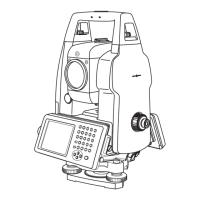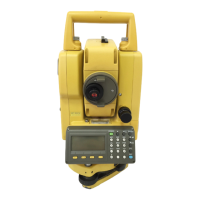
Do you have a question about the Topcon GPT-7000i Series and is the answer not in the manual?
| Absolute Encoder | Yes |
|---|---|
| Laser Pointer | Yes |
| Laser Plummet | Yes |
| Telescope Magnification | 30x |
| Compensator | Dual-axis |
| Operating Temperature Range | -20°C to +50°C |
| Type | Total Station |
| Automatic Collimation | Yes |
| Communication | Bluetooth |
| Angle Measurement Accuracy | 1" |
| Distance Measurement Range (with prism) | 5, 000m |
Precautions for safe operation and handling of the instrument.
Explanation of warning and caution displays for safe use.
Warnings and cautions for safe operation and handling of the instrument.
Requirements for the user and safety attire when operating.
Manufacturer's disclaimer for damages or losses.
Safety guidelines and precautions related to laser use.
Information on identifying and replacing caution labels.
Identification and labeling of the instrument's parts.
Overview of the instrument's display and main menu items.
Explanation of symbols, codes, and keys displayed on the screen.
Key combinations for accessing specific functions quickly.
Steps to configure automatic backlight dimming or turn-off.
Method to manually adjust the screen brightness using a slider.
Choosing automatic backlight control based on ambient light.
Procedure to manually save instrument data to memory.
Configuring automatic data backup when the instrument is suspended.
Procedure for performing a hardware reset if the instrument hangs.
Importance of closing the battery cover for normal operation.
Step-by-step guide to recalibrate the touch screen.
Description of the function of each key on the operating panel.
Correct procedure for turning off the instrument's power.
Soft key functions during angle measurement.
Soft key functions during distance measurement.
Soft key functions during coordinate measurement.
Graphic display for leveling the instrument using the circular level.
Function to assist rod person in stake-out work.
Displays light acceptance quantity for collimation.
Adjusting the brightness of the reticle illumination.
Controls the laser plummet for instrument centering.
Controls the laser pointer for collimation assistance.
Switching between prism and non-prism measurement modes.
Example of switching on the point guide using the star key.
Procedures for mounting, leveling, and centering the instrument on a tripod.
Connecting external battery packs for power.
Steps to turn on the instrument after leveling.
Interpreting the battery level indicator on the display.
Automatic correction for instrument mislevelment using tilt sensors.
Enabling or disabling tilt correction via soft keys.
Overview of errors compensated by software and manual adjustment.
Methods for inputting data using keyboard or software panel.
Procedures for inserting and extracting data memory cards.
Software for synchronizing data between the instrument and a PC.
Steps to establish a connection using ActiveSync.
Explanation of telescopic and wide-angle images on the display.
How to switch between different image views.
Adjusting the zoom level of the displayed image.
Modifying the contrast for better image clarity.
Toggling the visibility of cross-hairs on the image.
Procedures for measuring horizontal and vertical angles.
Changing between right and left horizontal angle measurement modes.
Setting and holding a specific horizontal angle for measurement.
Displaying vertical angle as percent grade.
Overview of distance measurement modes and principles.
Using the instrument with or without a prism.
Adjusting settings for atmospheric correction.
Inputting the prism constant value for accurate measurements.
Performing continuous distance measurements.
Measuring distance once or multiple times for averaging.
Selecting different measurement modes for speed and accuracy.
Performing stake out operations using preset distances.
Defining the instrument's position and orientation.
Entering instrument and prism heights for coordinate calculations.
Steps to perform coordinate measurements after setup.
Transferring measurement results to a data collector.
Outputting measurement results using the REC key.
Options for configuring measurement and communication parameters.
Specific settings related to measurement parameters like angle units and correction.
Configuration for data communication with other devices.
Settings for inputting values like measurement count and EDM off time.
Selection of units for temperature, pressure, angle, and distance.
Example of setting the S/A BUZZER parameter.
Verifying and setting the instrument's constant value for accuracy.
Procedures to check optical alignment of EDM and theodolite.
Steps to verify EDM and theodolite optical axis alignment.
Aligning the laser pointer's optical axis with the telescope.
General guidelines for adjusting theodolite functions.
Adjusting the plate level for perpendicularity to the vertical axis.
Adjusting the circular level for perpendicularity to the vertical axis.
Adjusting the vertical cross-hair for alignment.
Ensuring the telescope's line of sight is perpendicular to the horizontal axis.
Verifying and adjusting cross-hairs in different image modes.
Adjusting the laser plummet for centering on the measuring point.
Adjusting the optical plummet telescope for accurate vertical alignment.
Setting the vertical angle zero point for instrument coordinate origin.
Setting the instrument constant obtained from checking procedures.
Procedure for adjusting systematic error compensation.
Displaying the values of compensated systematic errors.
Setting the constant value for prisms other than Topcon's.
Formulas and examples for calculating atmospheric correction.
Directly setting temperature and pressure values for correction.
Setting atmospheric correction value (PPM) using chart or formula.
Formula for calculating distance with refraction and curvature correction.
Procedures for removing, charging, and installing the on-board battery.
Steps to detach the instrument from the tribrach.
Steps to attach the instrument to the tribrach.
Securing the tribrach locking lever to prevent accidental removal.
Specifications of the auto converter.
Specifications of the battery charger.
Specifications of the large capacity battery pack.
Specifications of the power cord PC-5.
Description of the solar filter.
Description of the optical plummet tribrach.
Description of the mini prism.
Specifications of the prism unit case.
Description of the gadget case.
Specifications of another prism unit case.
Reference to prism set descriptions.
Specifications of the power cord PC-6.
Description of the diagonal eyepiece.
Description of the trough compass.
Description of the solar reticle.
Description of the back pack.
Specifications of prism unit case.
Specifications of aluminum tripod.
Specifications of wooden tripod.
List of messages and their countermeasures.
List of error codes and their countermeasures.
Technical details of the telescope.
Technical details of the wide-angle and telescopic cameras.
Specifications for distance measurement range and accuracy.
Accuracy details for prism and non-prism modes.
Laser classification for distance measurement.
Minimum readable values and time for measurement modes.
Ranges for atmospheric correction, unit selections.
Method and accuracy of electronic angle measurement.
Type and range of tilt correction.
Details of the instrument's computer unit and display.
Specification for instrument height and level sensitivity.
Technical details of the optical plummet telescope.
Technical details of the laser pointer and plummet.
Information on card slot, physical dimensions, and weight.
Water/dust protection, temperature range, battery details.
Details of the battery charger.
Explanation of dual axis compensation and its benefits.











